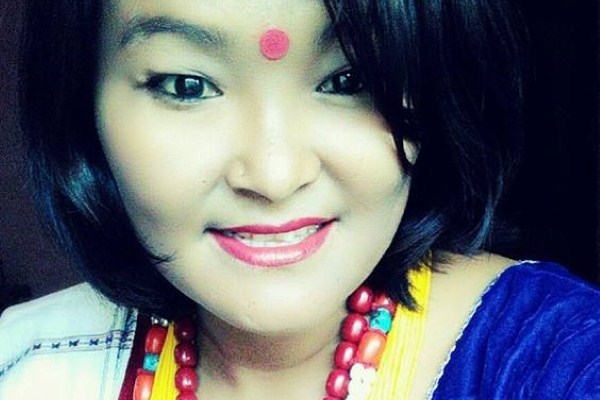विचार
KIRAT POLITICS in Term Definition
Rajendra Maharjan
Beauty, knowledge and discipline of human beings cannot be indifferent from the society where they are living. The sense of beauty and ugliness, good and bad, right and wrong, high and low, pure and impure is determined with the structure of the society and the culture. For the people living in a specific era or system or culture, they take a specific creation, composition, book, religion, male-female, dresses, food as being good, pure and beautiful but for the people from different time, society and circumstances, it is not necessary to feel so. It means the sense of beauty or knowledge or ethnology differs on the basis of country, time and circumstances, rather beauty is not absolute and immortal.
In the sense of beauty or consciousness or ethnology, ‘self’ plays a significant role whether it is needed or not. ‘Self’ or talking about ‘self’, there is a trend of describing objects, relation and creation in a beautifully, eternal and pure way which are connected to self. And it is almost impossible to find any person, family and society or the nation defining their ‘Self’ as impure, less beautiful and wretched. In the societies or communities around the globe, we can see the advocacy of beauty or purity or glory of ‘Self’ although such cannot be applied to all the things related to ‘Self”.
The Process of Othering
As much as it is important to narrate ‘Self’ or self-respect, it is also meaningful to narrate ‘Others’. ‘Others’ is another part of ‘Self’, which is an aspect and should be taken seriously from anthropology to aesthetics. There is a general trend of explaining all parts and aspects of ‘Self’ as good, moral, pure and beautiful but besides ‘Self’, the dimensions related to ‘Others’ as bad, immoral, impure and not beautiful. To define ‘Self’, it is always put in central or highest level while the objects different from ‘Self’ are categorized under ‘Others’. Due this categorization, there come the demarcation of oneness-others, high-low, touchable-untouchable. If we be able to develop the skill of critically analyzing ‘Self’, there we can lessen distance, limitation, classification or inequality including conflicts.
The communities, classes, race, gender, region and religion having monopoly on every government-power and property including knowledge, such people classify to the people from different community, class, race, gender, region and religion and their members under ‘Others’ and treat them so. In Nepal, ruling Khas-arya communities, identifying themselves in new constitution, they have made a provision of othering to other communities. The history refreshes the fact that almost all the constitution in Nepal have had othering in the name of religion, language, gender and region. Here in theology and holy books which guide to the constitution and have control in the society, Khas-arya community have had othering over a distinct community, Kirat, therefore, the historians and the authors in Nepal should search on how it is getting continuity. This would certainly help to understand closely not only diversified Nepali society but also recognition of beauty among rulers, religious power and the intellectuals and their perception of others communities. Therefore, it would assist to create an ideal equitable and democratic society.
Understanding conflict
between Self and Others
Jacques Derrida, a Christian philosopher has stated on the conflict between self and others and interaction, there are some contradictions and opposition written about others in the main system and culture. In any histories, theologies and various literatures written in an era of the history, it is found written about Kirat as they are taken as indigenous people in South Asia including Nepal. In such languages and writings, Kirats or alike communities are classified under ‘Others’, and the behavior towards them is found to be protesting, enmity and full of hatred.
According to Sanjeev Upreti, in Nepal, male and female, white and black, laborers and bourgeois, and Kirat and Bramin/Chhetri including all conflicting communities take and understand next party as ‘Others’ of ‘Self’. Thus, it is necessary to search on how Kirats were treated as others from the rulers with the help of government-power, property and knowledge of the nation and theology during the history of three thousand years that would help to create a right concept about ‘Others’ communities.
According to Michel Foucault, the narration and representation of social truth is through language, speech, images, signs and symbols, which relates with government-power like the relationship between nail and flesh. Because the truths connected with languages cannot be objective, rather power struggles in the society remain undivided. In this way, the social reality is termed as ‘Kirat Word’ and its meanings and wrong meanings as well.
Kirat both ‘Others’ and ‘Mlechchha’?
Whether Kirat or anyone else, we have a long history of defining and blaming not only the community, languages, color, culture and religion but also the region, state, nation as well as the continent as being Mlechchha, barbaric and dirty. According to Romila Thapar who has studied about Mlechchha, Mlechchha as a verb ‘to speak unclearly’. As a noun, it means ‘different speech or foreign language’. As an adjective, it has been highly used since the 1st century, for example, Mlechchha-country, Mlechchha-language, Mlechchha-marriage, Mlechchha-food, Mlechchha-speech and so on. (Thapar, 2001:133-155)
Highly affected Kirat word from this condition, we can see many hidden parts revealed. One example, the continuity of Arya history taking themselves as pure, holy, advance and best, but naming language, country and objects as Mlechchha and related to Kirat race. According to Baburam Achrya, as the name of Nepal was associated with Newari community, a community from Kirat, there is no symbol of Arya invasion at that time.
“The name of Nepal was named ‘Nepal’ after the name of ‘Nepar’, an indigenous group from Kirat or Agneyadeshi class. The population of this ethnic group, now, been found in Kathmandu and nearby places. Since they had their own government policy, in the views of Arya this country was known as a ‘poor-country’, ‘mlechchha-country’ or ‘Kirat-country’. (Acharya 2054 BS: 123-124)
Aryans dominated and hated not only the Newars in Kirat nation or state calling ‘Mlechchha’ but also to those ethnic groups and rulers who were close to Newars in relaiton. He adds, ‘non-arya’, Lichchhavi and Vides, from Arya-class, as they were accused of keeping close relationship with Newars, were treated hatefully from Indian-Aryan. Therefore, Indian Aryan started to count Lichchhivis and other Aryans as Mlechchhas. Gupta emperor Samudra Gupta has written on his great inscription about Nepal as being ‘Pratyantdesh’ and the nation of taxpayers. As given in the famous Sanskrit dictionary, ‘Pratyantdesh’ means ‘Mlechchha-country. (Acharya 2054 BS: 27)
According to Thapar, the wanderer stockmen, speaking in Hindu-Arya language used to call barbaric to the main dwellers who were spending city life, later some synonymous terms were used such as Mlechchha, Demon including Shudra. (Thapar: 2001:132-133). This question can provide many answers that why the citizens of Shindhughanti Civilization were called barbaric though they had the civilized and highest civilization. The relevant answer is that Arya intellectuals addressed to not only to uncivilized, poor or helpless people using such words like slave, bandit, demon, mlechchha, barbaric and dirty. Even today, there is a trend of saying barbaric to scold or complain or protest next party, but the word barbaric may be signaling next community.
Due to this, there raises a question on the process and culture of evaluating or defining or blaming others just taking own race in center and thinking own hereditary, racial, religious, cultural and social as highest, civilized and moral. The question linked to aesthetics would help to search and rethink of every word, meaning, definition, use and history in a new way.
twitter@rmaharjan72

 एक विद्वानले भनेका छन्–“एक वर्षका लागि हो भने धान रोप । एक दशकको लागि हो भने रुख रोप । एक शताब्दीको लागि हो भने जनतालाई शिक्षित गर ।” नेपाल एउटा विविधताले भरिएको देश हो जहाँ विभिन्न जातजाति भाषाभाषी, धर्म संस्कृति छ । जसको आफ्नै मौलिकपन छ ।
एक विद्वानले भनेका छन्–“एक वर्षका लागि हो भने धान रोप । एक दशकको लागि हो भने रुख रोप । एक शताब्दीको लागि हो भने जनतालाई शिक्षित गर ।” नेपाल एउटा विविधताले भरिएको देश हो जहाँ विभिन्न जातजाति भाषाभाषी, धर्म संस्कृति छ । जसको आफ्नै मौलिकपन छ ।
 भनिन्छ पूर्वबाट उदाउँने सूर्य अन्त्यमा गएर क्षितिजमा अस्ताँंछ । क्षितिजलाई खोज्दा खोज्दै मानिसको भौतिक शरीर एक दिन समाप्त हुन्छ । जसरी सूर्य पूर्वबाट उदाएर पश्चिम हुँदै क्षितिजमा हराउँछ । किनकि यो प्रकृतिको नियम हो । मानिस जन्मिएपछि एक दिन मृत्यु निश्चित छ ।
भनिन्छ पूर्वबाट उदाउँने सूर्य अन्त्यमा गएर क्षितिजमा अस्ताँंछ । क्षितिजलाई खोज्दा खोज्दै मानिसको भौतिक शरीर एक दिन समाप्त हुन्छ । जसरी सूर्य पूर्वबाट उदाएर पश्चिम हुँदै क्षितिजमा हराउँछ । किनकि यो प्रकृतिको नियम हो । मानिस जन्मिएपछि एक दिन मृत्यु निश्चित छ ।
 भाग्य र समय यति बलवाल छ जहाँ केवल भगवानको कृपा र समयको साथ हुन्छ । भगवानको कृपा र आशिर्वादविना मानिसले यो संसारको कल्पना गर्न गाह्रो छ । किनकि प्रत्येक जिवित प्राणीमा भगवानको आत्मारुपी शक्ति हुन्छ । जुन शक्तिको कारण भौतिक वस्तुहरुको विकास भइरहेको छ ।
भाग्य र समय यति बलवाल छ जहाँ केवल भगवानको कृपा र समयको साथ हुन्छ । भगवानको कृपा र आशिर्वादविना मानिसले यो संसारको कल्पना गर्न गाह्रो छ । किनकि प्रत्येक जिवित प्राणीमा भगवानको आत्मारुपी शक्ति हुन्छ । जुन शक्तिको कारण भौतिक वस्तुहरुको विकास भइरहेको छ ।
 ‘मित्रता– दिवस’मा उच्चतम परिणाम हात पारे– रेणु र पार्वतीले । महिला– मेयर उपमेयरको महत्व पछि पत्तो होला । तर, सशस्त्र युद्धको भार बिसाउँदा भन्दा ठूलो खुशी मिलेको हुनुपर्छ– प्रचण्ड परिवारलाई । चितवनका ‘छविलाल’को मात्र होइन सानेपा गठबन्धनको पनि ‘छवि’ उजेलियो ।
‘मित्रता– दिवस’मा उच्चतम परिणाम हात पारे– रेणु र पार्वतीले । महिला– मेयर उपमेयरको महत्व पछि पत्तो होला । तर, सशस्त्र युद्धको भार बिसाउँदा भन्दा ठूलो खुशी मिलेको हुनुपर्छ– प्रचण्ड परिवारलाई । चितवनका ‘छविलाल’को मात्र होइन सानेपा गठबन्धनको पनि ‘छवि’ उजेलियो ।
Comments